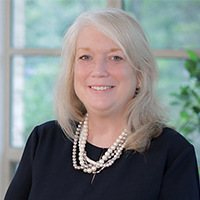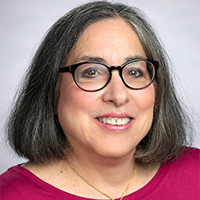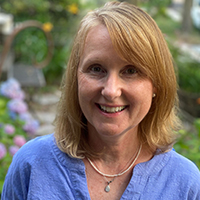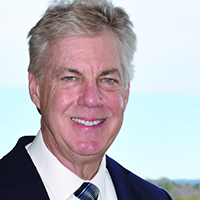Washington University: The Brown School Pushes Health Care for All

The George Warren Brown School at Washington University in St. Louis regularly takes the No. 2 spot on the U.S. News list of top social work graduate programs, and for good reason, according to the school’s Neidorff Family and Centene Corporation Dean Mary M. McKay (pictured right).
Among other things, through its master’s degrees in social work, public health and social policy and its doctorates in social work and public health sciences, the Brown School has become a leader in the health arena, particularly health care equity, McKay says. And not a moment too soon: “With COVID, we’ve seen higher levels of exposure and infection among Black and Brown populations, many times because they’re essential workers or don’t have access to testing in their local communities, and can harbor vaccine hesitancy based on mistrust of the medical profession.” It’s no surprise that the school’s new 10-year strategic plan is called “Driving Equity 2030.”
Health-Focused Research

Dr. Matthew W. Kreuter, the Kahn Family Professor of Public Health, is founder and senior scientist of the Brown School’s Health Communication Research Laboratory, which studies ways to improve the health and lives of low-income populations through intervention research. “We make sure it is effective and then link people to actual resources and services,” he says.
Recent federal grants, totaling some $2.5 million, have targeted COVID-19. The laboratory is a member of three national networks addressing COVID in local communities: the National Institutes of Health’s CEAL (Community-Engaged Alliance) and RADxUP (Rapid Assessment Diagnostics for Underserved Populations), and the Centers for Disease Control’s (CDC) Vaccine Confidence Network. Through CEAL, for example, “we have a project where we have designed door hangers with both information and action steps around COVID vaccination and sending kids back to school during COVID,” says Kreuter. Two canvassing companies contracted to the lab’s partner, the St. Louis Regional Response Team, deliver the information to thousands of homes each week and talk to residents.
A separate grant—for $500,000 from the CDC and shared with the university’s Prevention Research Center—supports research to reduce vaccine hesitancy in the African American community. The project reviews the effectiveness of different vaccination approaches “in terms of incentives, promotions, outreach or locations,” Kreuter says. At one vaccination event, held in a St. Louis city park where bicycles, air conditioners and $100 gift cards were given away, researchers observed “people who came to the event and then brought other family members back to get vaccinated as well.” On the other hand, its promotional materials didn’t say exactly where the event was in the sprawling park, making it hard to find.
Some 50 people now work at the Health Communication Research Laboratory, including many social work and public health students and recent graduates. “Most of these are paid research assistant positions, and even the practicum students who work with us get paid,” says Kreuter.
The Art of Implementation Science
Of course, what’s the point of social work research if it isn’t successfully transformed into practice? If intervention science tests new practices, interventions or policies to see if they work, implementation science investigates how to get the proven and effective ones into use, says Dr. Enola Proctor, Shanti K. Khinduka Distinguished Professor Emerita and director of the school’s Implementation Research Institute, funded by the National Institute of Mental Health. In other words, “how do we change systems of care, providers’ behaviors, decision makers’ notions, and support them in moving new and more effective approaches into their agencies, their clinics, their schools, the services they deliver?” (See also “Implementation Science: Putting Research Into Practice,” page 13.)
One Brown School student who is “all in” with implementation science is Sara Malone, who as an MSW student did field practicums in health care and mental health care while working as a research assistant in the Center for Mental Health Services Research, then led by Proctor. There Malone got to see first-hand the current thinking on implementing high-quality care, she says.
After graduation, Malone became a practitioner at the Washington University School of Medicine’s St. Louis Children’s Hospital, working with researchers, clinicians and implementation scientists like Proctor on “caring for kids with traumatic brain injury and how to help people best implement guidelines around brain injury care.” Now Malone is back at the Brown School getting a PhD focused on ensuring the sustainability of new interventions in clinical settings.
Since Malone got her MSW, Proctor helped add three formal courses on implementation science, the latest being “Implementation Strategies.” Malone says she’s “a little jealous” that she didn’t get to take those classes. Even so, Proctor says, that certainly hasn’t held Malone back from becoming one of implementation science’s rising stars.
Quinnipiac University: Getting Through a Pandemic

Laura Mutrie, MSW, LCSW, assistant clinical professor of social work and director of field education, talks about a tight relationship between classroom and field education, the Lions Low-Vision Clinic and field placements during COVID-19.
How is Quinnipiac’s social work program different from others?
I think one unusual thing is the way that field is integrated into our program. Since the program is fairly small, all field liaisons are full-time faculty members. So the integration of academics and field in our program is unusually tight. Because students’ monthly field seminar is led by their field liaison, that person will almost certainly have been one of their professors in class at some point.
Please describe your interesting Lions Low-Vision Clinic.
It was created by the Lions Club and the university’s Center for Interprofessional Healthcare Education, which coordinates all the interprofessional health care experiences on campus. Our department requires that students participate in a certain number of them for different practice classes. The role of social work in the clinic is to do a bio-psycho-social-spiritual assessment of each individual being evaluated by occupational therapy for low vision.
How has COVID-19 affected fieldwork at Quinnipiac?
There’s definitely a much tighter environment for placements not just because of COVID but because there’s an increased number of social work programs competing for field sites, both on-site and online. Still, beyond placing students with longtime partners such as the Root Center for Advanced Recovery, we’ve been able to add sites like the New Haven and New London school systems. There’s so much work to be done in schools, especially lately with distance learning and children’s levels of anxiety—and now with kids getting COVID more often.
UNC-Chapel Hill: Implementation Science and Putting Research Into Practice

Although implementation science has been part of health care education for years, it is relatively new to social work—and the University of North Carolina-Chapel Hill School of Social Work is 100 percent on board.
Implementation science, says Dr. Allison Metz, professor of practice and director of implementation practice, “is concerned with understanding what it takes to move something from a research setting into everyday practice on a scale that is meaningful, sustainable and will result in improved outcomes, all while advancing equity.” Dr. Gary Bowen, Kenan Distinguished Professor, has been a driving force behind instituting this area of study at the school, and during his five-year tenure as dean brought in Metz from the university’s National Implementation Research Network to help move things along.

Bowen is passionate about making sure any evidence-based treatment will be able to “scale up,” gain traction and become sustainable even before it’s implemented. An implementation scientist, he says, should be on the intervention design team to identify all of those issues, such as cost or complexity, “that could get in the way of even the most effective intervention, and start problem-solving them from day one.”
Now Metz is leading the development of an implementation practice online certificate. It will cover such areas as engaging stakeholders and sustaining change by strategies like creating teams and building system capacity. And it will have a strong equity component, says Bowen. “Not all racial or ethnic groups uptake, implement or sustain something in the same way. We have to right-size interventions and policies in the context of those dynamics.”